常见不规则名词复数形式表
- 格式:docx
- 大小:89.36 KB
- 文档页数:35
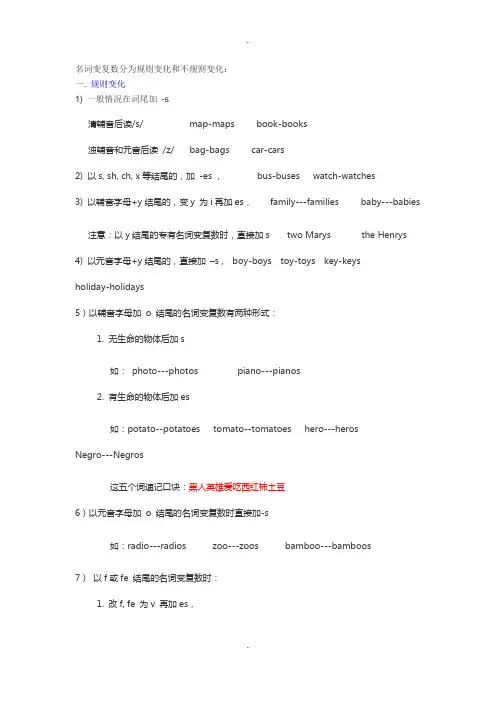
名词变复数分为规则变化和不规则变化:一. 规则变化1) 一般情况在词尾加-s清辅音后读/s/ map-maps book-books浊辅音和元音后读/z/ bag-bags car-cars2) 以s, sh, ch, x等结尾的,加-es ,bus-buses watch-watches3) 以辅音字母+y结尾的,变y 为i再加es ,family---families baby---babies注意:以y结尾的专有名词变复数时,直接加s two Marys the Henrys 4) 以元音字母+y结尾的,直接加–s , boy-boys toy-toys key-keysholiday-holidays5)以辅音字母加o 结尾的名词变复数有两种形式:1. 无生命的物体后加s如:photo---photos piano---pianos2. 有生命的物体后加es如:potato--potatoes tomato--tomatoes hero---herosNegro---Negros这五个词速记口诀:黑人英雄爱吃西红柿土豆6)以元音字母加o 结尾的名词变复数时直接加-s如:radio---radios zoo---zoos bamboo---bamboos7)以f或fe 结尾的名词变复数时:1. 改f, fe 为v 再加es,如:wife---wives knife---knives wolf---wolves thief---thieves shelf---shelves half---halves leaf---leaves self---selveslife---lives连成口诀就是:妻子持刀去宰狼,小偷吓得发了慌,躲在架后保己命,半片树叶遮目光。
2. 直接加s,如:gulf---gulfs roof---roofs chief---chiefs surf---surfsbelief---beliefs proof---proofshandkerchief—handkerchiefs;连成口诀就是:海湾边,屋顶上,首领奴仆两相望,谁说他们没信仰,证据就在手帕上。
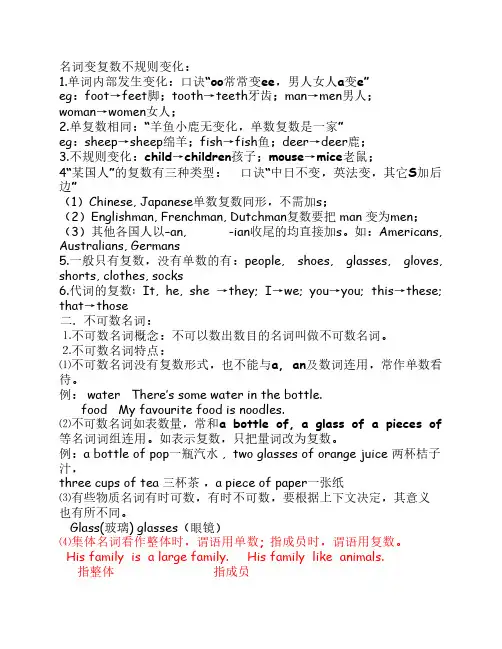
名词变复数不规则变化:1.单词内部发生变化:口诀“oo常常变ee,男人女人a变e”eg:foot→feet脚;tooth→teeth牙齿;man→men男人;woman→women女人;2.单复数相同:“羊鱼小鹿无变化,单数复数是一家”eg:sheep→sheep绵羊;fish→fish鱼;deer→deer鹿;3.不规则变化:child→children孩子;mouse→mice老鼠;4“某国人”的复数有三种类型:口诀“中日不变,英法变,其它S加后边”(1)Chinese, Japanese单数复数同形,不需加s;(2)Englishman, Frenchman, Dutchman复数要把 man 变为men;(3)其他各国人以–an, -ian收尾的均直接加s。
如:Americans, Australians, Germans5.一般只有复数,没有单数的有:people, shoes, glasses, gloves, shorts, clothes, socks6.代词的复数: It, he, she →they; I→we; you→you; this→these; that→those二. 不可数名词:⒈不可数名词概念:不可以数出数目的名词叫做不可数名词。
⒉不可数名词特点:⑴不可数名词没有复数形式,也不能与a, an及数词连用,常作单数看待。
例: water There’s some water in the bottle.food My favourite food is noodles.⑵不可数名词如表数量,常和a bottle of, a glass of a pieces of 等名词词组连用。
如表示复数,只把量词改为复数。
例:a bottle of pop一瓶汽水 , two glasses of orange juice 两杯桔子汁,three cups of tea 三杯茶,a piece of paper一张纸⑶有些物质名词有时可数,有时不可数,要根据上下文决定,其意义也有所不同。
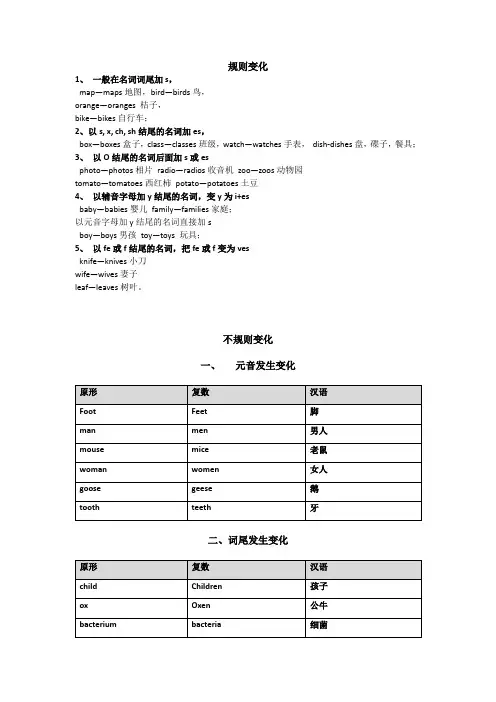
规则变化
1、一般在名词词尾加s,
map—maps地图,bird—birds鸟,
orange—oranges 桔子,
bike—bikes自行车;
2、以s, x, ch, sh结尾的名词加es,
box—boxes盒子,class—classes班级,watch—watches手表,dish-dishes盘,碟子,餐具;
3、以O结尾的名词后面加s或es
photo—photos相片radio—radios收音机zoo—zoos动物园
tomato—tomatoes西红柿potato—potatoes土豆
4、以辅音字母加y结尾的名词,变y为i+es
baby—babies婴儿family—families家庭;
以元音字母加y结尾的名词直接加s
boy—boys男孩toy—toys 玩具;
5、以fe或f结尾的名词,把fe或f变为ves
knife—knives小刀
wife—wives妻子
leaf—leaves树叶。
不规则变化
一、元音发生变化
二、词尾发生变化
三、单数、复数形式不变
四、只有复数的名词
五、第一个或最后一个词变成复数
六、构成合成名词的两个词都要变为复数。
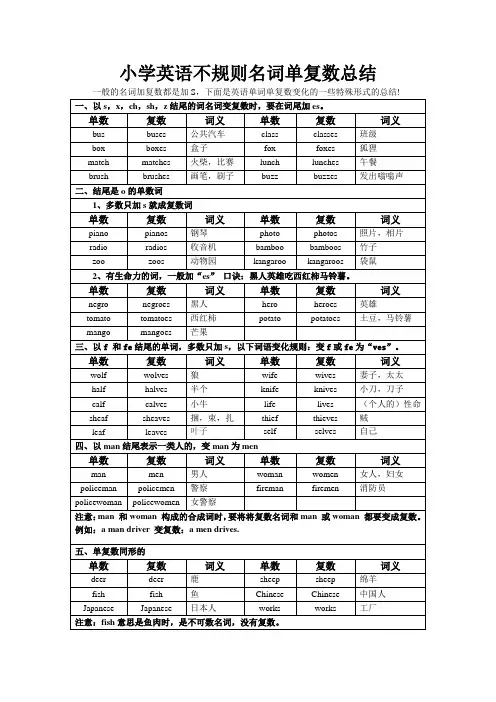

名词变复数不规则变化标准化管理部编码-[99968T-6889628-J68568-1689N]名词变复数不规则变化:1.单词内部发生变化:口诀“oo常常变ee,男人女人a变e”eg:foot→feet脚;tooth→teeth牙齿;man→men男人;woman→women女人;2.单复数相同:“羊鱼小鹿无变化,单数复数是一家”eg:sheep→sheep绵羊;fish→fish鱼;deer→deer鹿;3.不规则变化:child→children孩子;mouse→mice老鼠;4“某国人”的复数有三种类型:口诀“中日不变,英法变,其它S加后边”(1)Chinese, Japanese单数复数同形,不需加s;(2)Englishman, Frenchman, Dutchman复数要把 man 变为men;(3)其他各国人以–an, -ian收尾的均直接加s。
如:Americans, Australians, Germans5.一般只有复数,没有单数的有:people, shoes, glasses, gloves, shorts, clothes, socks6.代词的复数: It, he, she →they; I→we; you→you; this→these; that→those二.不可数名词:⒈不可数名词概念:不可以数出数目的名词叫做不可数名词。
⒉不可数名词特点:⑴不可数名词没有复数形式,也不能与a, an 及数词连用,常作单数看待。
例:water There’s some water in the bottle.food My favourite food is noodles.⑵不可数名词如表数量,常和a bottle of,a glass of a pieces of 等名词词组连用。
如表示复数,只把量词改为复数。
例:a bottle of pop一瓶汽水 , two glasses of orange juice 两杯桔子汁,three cups of tea 三杯茶,a piece of paper一张纸⑶有些物质名词有时可数,有时不可数,要根据上下文决定,其意义也有所不同。
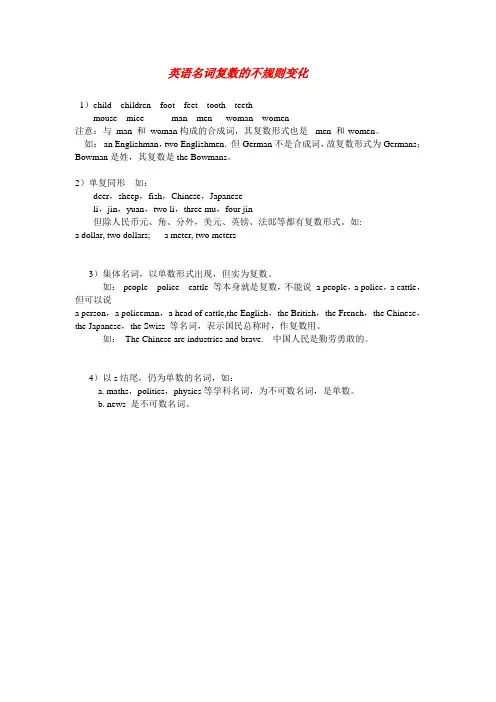
英语名词复数的不规则变化
1)child---children foot---feet tooth---teeth
mouse---mice man---men woman---women
注意:与man 和woman构成的合成词,其复数形式也是-men 和-women。
如:an Englishman,two Englishmen. 但German不是合成词,故复数形式为Germans;Bowman是姓,其复数是the Bowmans。
2)单复同形如:
deer,sheep,fish,Chinese,Japanese
li,jin,yuan,two li,three mu,four jin
但除人民币元、角、分外,美元、英镑、法郎等都有复数形式。
如:
a dollar, two dollars; a meter, two meters
3)集体名词,以单数形式出现,但实为复数。
如:people police cattle 等本身就是复数,不能说a people,a police,a cattle,但可以说
a person,a policeman,a head of cattle,the English,the British,the French,the Chinese,the Japanese,the Swiss 等名词,表示国民总称时,作复数用。
如:The Chinese are industries and brave.中国人民是勤劳勇敢的。
4)以s结尾,仍为单数的名词,如:
a. maths,politics,physics等学科名词,为不可数名词,是单数。
b. news 是不可数名词。
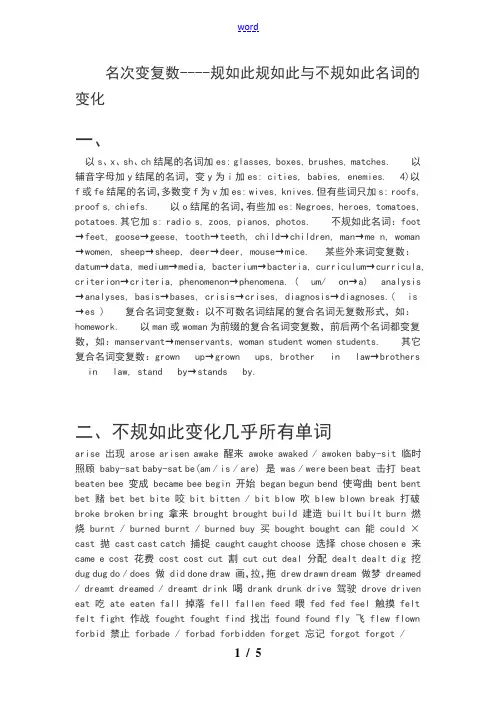
名次变复数----规如此规如此与不规如此名词的变化一、以s、x、sh、ch结尾的名词加es: glasses, boxes, brushes, matches.以辅音字母加y结尾的名词,变y为i加es: cities, babies, enemies.4)以f或fe结尾的名词,多数变f为v加es: wives, knives.但有些词只加s: roofs, proof s, chiefs.以o结尾的名词,有些加es: Negroes, heroes, tomatoes, potatoes.其它加s: radio s, zoos, pianos, photos.不规如此名词:foot →feet, goose→geese, tooth→teeth, child→children, man→me n, woman →women, sheep→sheep, deer→deer, mouse→mice. 某些外来词变复数:datum→data, medium→media, bacterium→bacteria, curriculum→curricula, criterion→criteria, phenomenon→phenomena. (um/on→a)analysis →analyses, basis→bases, crisis→crises, diagnosis→diagnoses.(is→es )复合名词变复数:以不可数名词结尾的复合名词无复数形式,如:homework.以man或woman为前缀的复合名词变复数,前后两个名词都变复数,如:manservant→menservants, woman student women students.其它复合名词变复数:grown up→grown ups, brother in law→brothers in law, stand by→stands by.二、不规如此变化几乎所有单词arise 出现 arose arisen awake 醒来 awoke awaked / awoken baby-sit 临时照顾 baby-sat baby-sat be(am / is / are) 是 was / were been beat 击打 beat beaten bee 变成 became bee begin 开始 began begun bend 使弯曲 bent bent bet 赌 bet bet bite 咬 bit bitten / bit blow 吹 blew blown break 打破broke broken bring 拿来 brought brought build 建造 built built burn 燃烧 burnt / burned burnt / burned buy 买 bought bought can 能 could ×cast 抛 cast cast catch 捕捉 caught caught choose 选择 chose chosen e 来came e cost 花费 cost cost cut 割 cut cut deal 分配 dealt dealt dig 挖dug dug do / does 做 did done draw 画,拉,拖 drew drawn dream 做梦 dreamed / dreamt dreamed / dreamt drink 喝 drank drunk drive 驾驶 drove driven eat 吃 ate eaten fall 掉落 fell fallen feed 喂 fed fed feel 触摸 felt felt fight 作战 fought fought find 找出 found found fly 飞 flew flown forbid 禁止 forbade / forbad forbidden forget 忘记 forgot forgot /forgotten forgive 原谅 forgave forgiven freeze 结冰 froze frozen get 得到 got got give 给 gave given go 去 went gone grow 成长 grew grown hang 挂 / 绞死 hung / hanged hung / hanged have / has 有 had had be was/were been (be动词) do did done (助动词) speak spoke spoken (讲话) read read read (阅读) cut cut cut (切) cost cost cost (花费) go went gone (去,走) feel felt felt (感觉) dig dug dug (挖) overe overcame overe (克制) e came e (来) write wrote written (写) get got gotten (自己查一下,这个词要看用在那里了) see saw seen (看) spend spent spent (花费) put put put (放下) find fought fought (找,查明) deal dealt dealt (分配) bend bent bent (使…变曲) fight fought fought (搏斗,奋斗) keep kept kept (留下,保存,继续) lay laid lain (放置,躺下,保存) lend lent lent (借出,借给) lose lost lost(失去,丧失) sit sat sat (坐,就坐) sleep slept slept(睡觉,睡着) 英语不规如此动词表 Infinitive Past Tense Past Participle 不定式过去式过去分词 abide abode,abided abode,abided arise arose arisen awake awoke,awaked awoken,awaked be(am,is,are) was;were been bear bore borne,born beat beat beaten bee became bee befall befell befallen beget begot begotten,begot begin began begun behold beheld beheld bend bent bent bereave bereaved,bereft bereaved,bereft beseech besought,beseeched besought,beseeched beset beset beset bespeak bespoke bespoken,bespoke bespread bespread bespread bestrew bestrewed bestrewn,bestrewed bestride bestrode,bestrid bestridden,bestrid bet bet,betted bet,betted betake betook betaken bethink bethought bethought bid bade,bid bidden,bid bide bode,bided bided bind bound bound bite bit bitten,bit bleed bled bled blend blended,blent blended,blent bless blessed,blest blessed,blest blow blew blown break broke broken breed bred bred bring brought brought broadcast broadcast,broadcasted broadcast,broadcasted browbeat browbeat browbeaten build built built burn burnt,burned burnt,burned burst burst burst buy bought bought cast cast cast catch caught caught chide chid,chided chid,chidden,chided choose chose chosen cleavecleaved,cleft,clove cleaved,cleft,cloven cleave cleaved,clave cleaved cling clung clung clothe clothed,clad clothed,clad e came e cost cost cost creep crept crept crow crowed,crew crowed cut cut cut deal dealt dealt dig dug dug dispread dispread dispread do did done draw drew drawn dream dreamed,dreamt dreamed,dreamt drink drank drunk drive drove driven dwell dwelt,dwelled dwelt,dwelled eat ate eaten fall fell fallen feed fed fed feel felt felt fight fought fought find found found flee fled fled fling flung flung fly flew flown forbear forbore forborne forbid forbade,forbad forbidden,forbid fordo fordid fordone forecast forecast,forecastedforecast,forecasted forego forewent foregone foreknow foreknew foreknown forerun foreran forerun foresee foresaw foreseen foreshow foreshowed foreshown foretell foretold foretold forget forgot forgotten,forgot forgive forgave forgiven forsake forsook forsaken forswear forswore forsworn freeze froze frozen gainsay gainsaid gainsaid get got got,gotten gild gilded,gilt gilded,gilt gird girded,girt girded,girt give gave given go went gone grave graved graven,graved grind ground ground grow grew grown hamstring hamstrung,hamstringed hamstrung,hamstringed hang hung,hanged hung,hanged have(has) had had hear heard heard heave heaved,hove heaved,hove hew hewed hewn,hewed hide hid hidden,hid hit hit hit hold held held hurt hurt hurt inlay inlaid inlaid keep kept kept kneel knelt,kneeled knelt,kneeled knit knitted,knit knitted,knit know knew known lade laded laded,laden lay laid laid lead led led lean leaned,leant leaned,leant leap leapt,leaped leapt,leaped learn learned,learnt learned,learnt leave left left lend lent lent let let let lie lay lain light lit,lighted lit,lighted lose lost lost make made made mean meant meant meet met met melt melted melted,molten misdeal misdealt misdealt misgive misgave misgiven mislay mislaid mislaid mislead misled misled mistake mistook mistaken misunderstand misunderstood misunderstood mow mowed mowed,mown outbid outbid outbid,outbidden outbreed outbred outbred outdo outdid outdone outdraw outdrew outdrawn outgo outwent outgone outgrow outgrew outgrown outlay outlaid outlaid outride outrode outridden outrun outran outrun outsell outsold outsold outshine outshone outshone outshoot outshot outshot outsit outsat outsat outspend outspent outspent outspread outspread outspread outwear outwore outworn overbear overbore overborne overbid overbid overbidden,overbid overblow overblew overblown overbuild overbuilt overbuilt overbuy overbought overbought overcast overcast overcast overe overcame overe overdo overdid overdone overdraw overdrew overdrawn overdrive overdrove overdriven overeat overate overeaten overfeed overfed overfed overfly overflew overflown overgrow overgrew overgrown overhang overhung overhung overhear overheard overheard overlay overlaid overlaid overleap overleapt,overleaped overleapt,overleaped overlie overlay overlain overpay overpaid overpaid override overrode overridden overrun overran overrun oversee oversaw overseen oversell oversold oversold overset overset overset oversew oversewed oversewed,oversewn overshoot overshot overshot oversleep overslept overslept overspend overspent overspent overspread overspread overspread overtake overtook overtaken overthrow overthrew overthrownoverwind overwound overwound overwrite overwrote overwritten partake partook partaken pay paid paid precast precast precast prove proved proved,proven put put put quit quitted,quit quitted,quit read read[red] read[red] reave reaved,reft reaved,reft rebuild rebuilt rebuilt recast recast recast reeve rove,reeved rove,reeved relay relaid relaid rend rent rent repay repaid repaid reset reset reset retell retold retold rid rid,ridded rid,ridded ride rode ridden ring rang rung rise rose risen rive rived riven,rived run ran run saw sawed sawn,sawed say said said see saw seen seek sought sought sell sold sold send sent sent set set set sew sewed sewn,sewed shake shook shaken shave shaved shaved,shaven shear sheared shorn,sheared shed shed shed shine shone shone shoe shod,shoedshod,shoed,shodden shoot shot shot show showed shown,showed shred shredded,shred shredded,shred shrink shrank,shrunk shrunk,shrunken shrive shrove,shrived shriven,shrived shut shut shut sing sang,sung sung sink sank,sunk sunk,sunken sit sat sat slay slew slain sleep slept slept slide slid slid,slidden sling slung slung slink slunk slunk slit slit slit smell smelt,smelled smelt,smelled smite smote smitten,smote sow sowed sown,sowed speak spoke spoken speed sped,speeded sped,speeded spell spelt,spelled spelt,spelled spend spent spent spill spilt,spilled spilt,spilled spin spun spun spit spat,spit spat,spit split split split spoil spoilt,spoiled spoilt,spoiled spread spread spread spring sprang,sprung sprung stand stood stood stave staved,stove staved,stove steal stole stolen stick stuck stuck sting stung stung stink stank,stunk stunk strew strewed strewn,strewed stride strode stridden,strid strike struck struck,stricken string strung strung strive strove,strived striven,strived swear swore sworn sweat sweat,sweated sweat,sweated sweep swept swept swell swelled swollen,swelled swim swam swum swing swung swung take took taken teach taught taught tear tore torn tell told told think thought thought thrive throve,thrived thriven,thrived throw threw thrown thrust thrust thrust tread trod trodden,trod unbend unbent unbent unbind unbound unbound unbuild unbuilt unbuilt underbid underbid underbidden,underbid underbuy underbought underbought undercut undercut undercut underfeed underfed underfed undergo underwent undergone underlay underlaid underlaid underlet underlet underlet underlie underlay underlain underpay underpaid underpaid underrun underran underrun undersell undersold undersold underset underset underset undershoot undershot undershot understand understood understood undertake undertook undertaken underwrite underwrote underwritten undoundid undone undraw undrew undrawn unfreeze unfroze unfrozen ungird ungirded,ungirt ungirded,ungirt unhang unhung unhung unknit unknitted,unknit unknitted,unknit unlade unladed unladed,unladen unlay unlaid unlaid unlearn unlearnt,unlearned unlearnt,unlearned unmake unmade unmade unreeve unrove,unreeved unrove,unreeved unsay unsaid unsaid unset unset unset unsling unslung unslung unstick unstuck unstuck unstring unstrung unstrung unswear unswore unsworn unteach untaught untaught unthink unthought unthought untread untrod untrodden,untrod unweave unwove unwoven unwind unwound unwound upbuild upbuilt upbuilt uphold upheld upheld uppercut uppercut uppercut uprise uprose uprisen upset upset upset upsweep upswept upswept upswing upswung upswung wake waked,woke waked,woken,woke waylay waylaid waylaid wear wore worn weave wove woven wed wedded,wed wedded,wed weep wept wept wet wetted,wet wetted,wet win won won wind winded,wound winded,wound wit(wot) wist wist withdraw withdrew withdrawn withhold withheld withheld withstand withstood withstood work worked,wrought worked,wrought wring wrung wrung write wrote written。
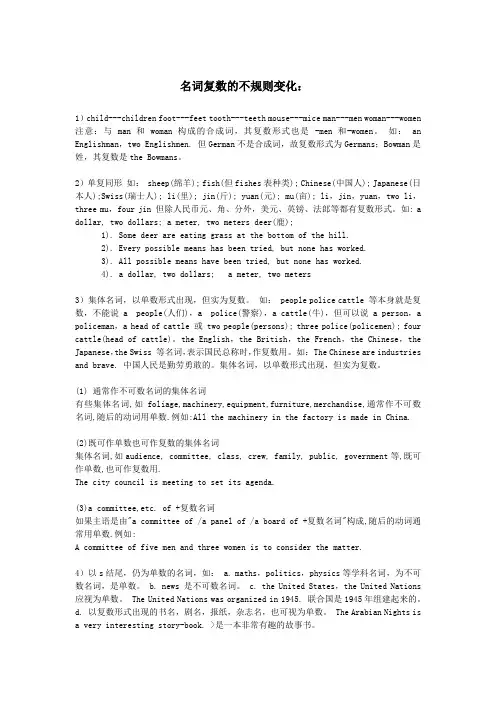
名词复数的不规则变化:1)child---children foot---feet tooth---teeth mouse---mice man---men woman---women 注意:与 man 和 woman构成的合成词,其复数形式也是 -men 和-women。
如: an Englishman,two Englishmen. 但German不是合成词,故复数形式为Germans;Bowman是姓,其复数是the Bowmans。
2)单复同形如: sheep(绵羊); fish(但fishes表种类); Chinese(中国人); Japanese(日本人);Swiss(瑞士人); li(里); jin(斤); yuan(元); mu(亩); li,jin,yuan,two li,three mu,four jin 但除人民币元、角、分外,美元、英镑、法郎等都有复数形式。
如: a dollar, two dollars; a meter, two meters deer(鹿);1). Some deer are eating grass at the bottom of the hill.2). Every possible means has been tried, but none has worked.3). All possible means have been tried, but none has worked.4). a dollar, two dollars; a meter, two meters3)集体名词,以单数形式出现,但实为复数。
如: people police cattle 等本身就是复数,不能说 a people(人们),a police(警察),a cattle(牛),但可以说 a person,a policeman,a head of cattle 或 two people(persons); three police(policemen); four cattle(head of cattle)。
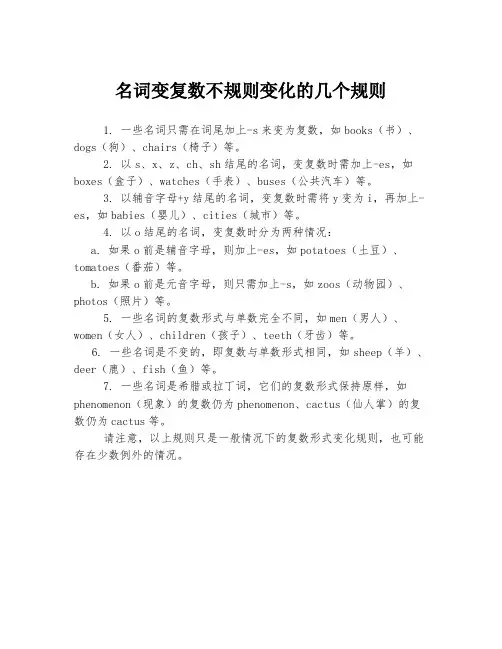
名词变复数不规则变化的几个规则
1. 一些名词只需在词尾加上-s来变为复数,如books(书)、dogs(狗)、chairs(椅子)等。
2. 以s、x、z、ch、sh结尾的名词,变复数时需加上-es,如boxes(盒子)、watches(手表)、buses(公共汽车)等。
3. 以辅音字母+y结尾的名词,变复数时需将y变为i,再加上-es,如babies(婴儿)、cities(城市)等。
4. 以o结尾的名词,变复数时分为两种情况:
a. 如果o前是辅音字母,则加上-es,如potatoes(土豆)、tomatoes(番茄)等。
b. 如果o前是元音字母,则只需加上-s,如zoos(动物园)、photos(照片)等。
5. 一些名词的复数形式与单数完全不同,如men(男人)、women(女人)、children(孩子)、teeth(牙齿)等。
6. 一些名词是不变的,即复数与单数形式相同,如sheep(羊)、deer(鹿)、fish(鱼)等。
7. 一些名词是希腊或拉丁词,它们的复数形式保持原样,如phenomenon(现象)的复数仍为phenomenon、cactus(仙人掌)的复数仍为cactus等。
请注意,以上规则只是一般情况下的复数形式变化规则,也可能存在少数例外的情况。
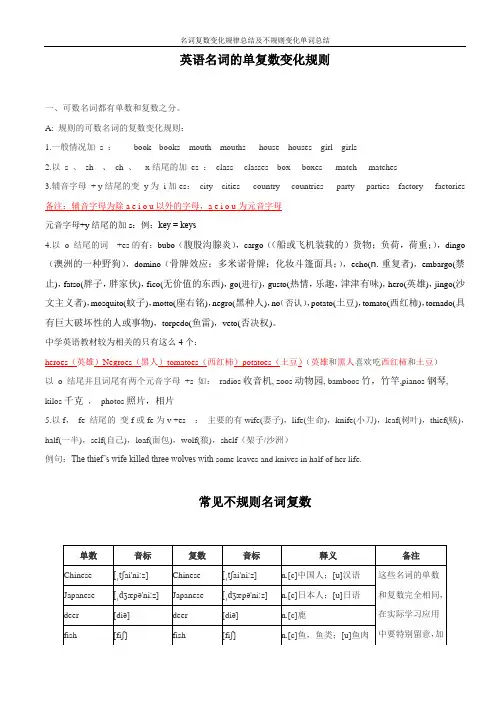
英语名词的单复数变化规则一、可数名词都有单数和复数之分。
A: 规则的可数名词的复数变化规则:1.一般情况加s :book-- books mouth---mouths house---houses girl---girls2.以s 、sh 、ch 、x结尾的加es :class--- classes box----boxes match----matches3.辅音字母+ y结尾的变y为i加es:city---cities country----countries party----parties factory----factories 备注:辅音字母为除a e i o u以外的字母,a e i o u为元音字母元音字母+y结尾的加s:例:key = keys4.以o 结尾的词+es的有:bubo(腹股沟腺炎),cargo((船或飞机装载的)货物;负荷,荷重;),dingo (澳洲的一种野狗),domino(骨牌效应;多米诺骨牌;化妆斗篷面具;),echo(n. 重复者),embargo(禁止),fatso(胖子,胖家伙),fico(无价值的东西),go(进行),gusto(热情,乐趣,津津有味),hero(英雄),jingo(沙文主义者),mosquito(蚊子),motto(座右铭),negro(黑种人),no(否认),potato(土豆),tomato(西红柿),tornado(具有巨大破坏性的人或事物),torpedo(鱼雷),veto(否决权)。
中学英语教材较为相关的只有这么4个:heroes(英雄)Negroes(黑人)tomatoes(西红柿)potatoes(土豆)(英雄和黑人喜欢吃西红柿和土豆)以o 结尾并且词尾有两个元音字母+s 如:radios收音机, zoos动物园, bamboos竹,竹竿,pianos钢琴, kilos千克,photos照片,相片5.以f,fe 结尾的变f或fe为v +es :主要的有wife(妻子),life(生命),knife(小刀),leaf(树叶),thief(贼),half(一半),self(自己),loaf(面包),wolf(狼),shelf(架子/沙洲)例句:The thief’s wife killed three wolves with some leaves and knives in half of her life.常见不规则名词复数1. 英语中有些名词单复数同行,主要有以下几类:A)、某些动物名词B)、某些表示人的名词C)、craft及由-craft构成的名词D)、某些表示数量的名词E)、其他2. 以下这些名词单复数同形:antelope 羚羊,bison 野牛,buffalo 水牛,crab 螃蟹,deer 鹿,fish 鱼,reindeer 驯鹿,sheep 绵羊;Burmese 缅甸人,Cantonese 广东人,Chinese 中国人,counsel 法律顾问,kin 亲属,Japanese 日本人,Swiss瑞士人;aircraft 飞机,craft 飞机,spacecraft 太空船;brance 双,score 二十;series 系列;species 种类;means方法只有复数形式的名词trousers裤子,pants裤子,shorts短裤glasses眼镜,compasses圆规,scales天平,pliers钳子,clips剪子。
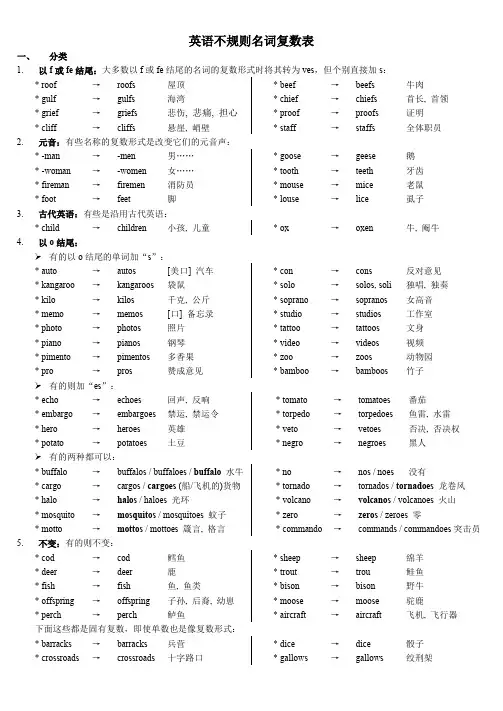
英语不规则名词复数表一、分类1.以f或fe结尾:大多数以f或fe结尾的名词的复数形式时将其转为ves,但个别直接加s:* roof→roofs屋顶* gulf→gulfs海湾* grief→griefs悲伤, 悲痛, 担心* cliff→cliffs悬崖, 峭壁* beef→beefs牛肉* chief→chiefs首长, 首领* proof→proofs证明* staff→staffs全体职员2.元音:有些名称的复数形式是改变它们的元音声:* -man→-men男……* -woman→-women女……* fireman→firemen消防员* foot→feet脚* goose→geese鹅* tooth→teeth牙齿* mouse→mice老鼠* louse→lice虱子3.古代英语:有些是沿用古代英语:* child→children小孩, 儿童* ox→oxen牛, 阉牛4.以o结尾:有的以o结尾的单词加“s”:* auto→autos[美口] 汽车* kangaroo→kangaroos袋鼠* kilo→kilos千克, 公斤* memo→memos[口] 备忘录* photo→photos照片* piano→pianos钢琴* pimento→pimentos多香果* pro→pros赞成意见* con→cons反对意见* solo→solos, soli独唱, 独奏* soprano→sopranos女高音* studio→studios工作室* tattoo→tattoos文身* video→videos视频* zoo→zoos动物园* bamboo→bamboos竹子有的则加“es”:* echo→echoes回声, 反响* embargo→embargoes禁运, 禁运令* hero→heroes英雄* potato→potatoes土豆* tomato→tomatoes番茄* torpedo→torpedoes鱼雷, 水雷* veto→vetoes否决, 否决权* negro→negroes黑人有的两种都可以:* buffalo→buffalos / buffaloes / buffalo水牛* cargo→cargos / cargoes (船/飞机的)货物* halo→halos / haloes 光环* mosquito→mosquitos / mosquitoes 蚊子* motto→mottos / mottoes 箴言, 格言* no→nos / noes没有* tornado→tornados / tornadoes龙卷风* volcano→volcanos / volcanoes 火山* zero→zeros / zeroes 零* commando→commands / commandoes突击员5.不变:有的则不变:* cod→cod鳕鱼* deer→deer鹿* fish→fish鱼, 鱼类* offspring→offspring子孙, 后裔, 幼崽* perch→perch鲈鱼* sheep→sheep绵羊* trout→trou鲑鱼* bison→bison野牛* moose→moose驼鹿* aircraft→aircraft飞机, 飞行器下面这些都是固有复数,即使单数也是像复数形式:* barracks→barracks兵营* crossroads→crossroads十字路口* dice→dice骰子* gallows→gallows绞刑架* headquarters→headquarters总部* means→means方法, 手段, 途径* series→series系列* species→species物种6.借用单词:英语中有些单词是借用其他语言的。
英语不规则名词表例题:(2016广州市调研考)▲绝对不可数名词Happiness, news, information, goodness, progress, fun, harm, milk, furniture, weather, music, health, luck, kindness, courage, wealth, bravery, importance, 在使用这些词时,不管其前面有多少修饰语,其前一定不要用不定冠词a或an.sand,rice,water,fish<译为鱼肉不可数》money、milk等等都是:-) 所以例子我就举这两个。
告诉你一个简单的判断方法:如果一个名词所代表的事物,“切”成两半之后仍为该物(比如说“water”一词)分成两半之后仍称做“water”,那么它就是不可数名词。
反之,例如“bike”,分成两半之后就不是它了!所以自行车可数。
液体,肉类,抽象名词,米饭,钱,知识常用不可数名词bread面包beer啤酒cloth 布coffee咖啡cream奶油dust尘土gin杜松子酒glass玻璃gold黄金ice冰jam果酱oil油paper 纸sand沙soap肥皂stone石头tea茶water水juice饮料wine葡萄酒wood木头advice忠告/主意beauty美丽,漂亮courage勇气death死亡experience经验fear担心help帮助hope希望horror恐惧information消息/信息knowledge知识mercy仁慈pity同情relief救济suspicion猜疑work工作baggage行李camping露营damage损害furniture家具luggage 行李parking停车shopping购物weather天气money金钱people人物 a bit of news一件消息 a cake of soap一块肥皂 a drop of oil一滴油 a grain of sand一粒沙子 a pane of glass一块玻璃 a piece of advice一条忠告 a pot of jam一罐果酱 a sheet of paper一页纸 a box of milk一盒牛奶最常见的不可数名词有:advice, baggage, change(零钱), furniture, hair, homework, information, knowledge, luggage, money, news, progress, traffic2、其它不可数名词还有:absence, age, anger, courage, energy, equipment, experience, failure, fear, food, fun, health, ice, industry, kindness, labour, luck, marriage, music, nature, paper, peace, pleasure, power, pride, rain, research, respect, safety, salt, sand, silence, sleep, strength, snow, technology, time, trade, transport, travel, trust, truth, waste, water, wealth, weather, wind, work(工作)▲修饰不可数名词的量词:a piece of newsa good piece of newsa bad piece of news.An exciting piece of newsmuch newspapertwo pieces of informationa set of furnituremuch machinerya lot of jewelleryenough chalkthree pieces of bread much homework a lot of work much experience a bar of chocolate a stick of candy a cake of soap a bowl of soup a mouthful of rice a spoonful of sugar a handful of sand a cup of coffee a grain of rice a sum ofmoney a block of ice a box of chalk a glass of milk a basin of water an article of clothing a suit of clothes much food enough money a box of gold a pile of sandfour sheets of paper five bottles of wine a glass of juice a bottle of jam a bowl of soup a grain of rice a sum of money a block of ice常用不可数名词bread面包beer啤酒cloth布coffee咖啡cream奶油dust尘土gin杜松子酒glass玻璃gold黄金ice冰jam果酱oil油paper纸sand沙soap肥皂stone石头tea茶water 水juice饮料wine葡萄酒wood木头advice忠告/主意beauty美丽,漂亮courage勇气death死亡experience经验fear担心help帮助hope希望horror恐惧information消息/信息knowledge知识mercy仁慈pity同情relief救济suspicion猜疑work工作baggage行李camping露营damage损害furniture家具luggage 行李parking停车shopping购物weather气候只能修饰不可数名词的词语有: much, a great deal of, a great / large amount of等。
不规则复数变化单词
不规则复数名词,也被称为不规则复数形态,是指可数名词中结尾不以s和es结尾的名词。
这些不规则复数名词在英语中有很多,例如:'man'变为'men','woman'变为'women','child'变为
'children'等。
下面是一些常见的不规则复数变化规则:
1.大部分以f和fe结尾的名词去掉f/fe,变成ves,但也有个别例外,直接在f后面加s。
2.以O结尾的名词复数形式很多是加es,一些在英语中也属于外来词的以O结尾的名词直接以S结尾,像bamboo——bamboos,photo——photos。
3.单复数同行,即单词本身既是单数也是复数。
4.通过内部元音变换等方式构成。
比如变-a-为-e-如:man - men(成年男人),woman - women(成年女性);变-oo-为-ee-如:foot - feet(脚),goose - geese(鹅),tooth - teeth(牙齿);变-ouse为-ice如:mouse - mice(老鼠)。
5."某国人"的复数有三种类型:口诀“人羊鱼鹿无变化,单数复数是一家”。
以上所述是常见不规则复数名词的一些变化规则,但总的来说,大部分不规则复数名词的变化需要通过记忆来掌握。
名词复数的不规则变化:1.不规则形式:child→children(儿童)man→men(男人)woman→women (女人)an Englishman→two Englishmen(英国人)foot→feet(脚)tooth→teeth(牙)mouse→mice(老鼠)ox →oxen(公牛)goose→geese(鹅)2.单复同形:deer,sheep,fish,Chinese,Japanese, species,means,Swiss除人民币,美元、英镑、法郎等都有复数形式。
如:a dollar,two dollars; a meter,twometers3.集体名词,以单数形式出现,但实为复数:people police cattle是复数(OK :a person,a policeman,ahead of cattle,the English,the British,the French,the Chinese,the Japanese,the Swiss )(Error:a people,a police,a cattle )表示国民总称时,作复数用。
(The Chinese are industries and brave. 中国人民是勤劳勇敢的。
)4.以s结尾,仍为单数的名词maths,politics,physics等学科名词,为不可数名词,是单数。
news是不可数名词。
5.表示由两部分构成的东西,glasses(眼镜) trousers (长裤) clothes(衣服)若表达具体数目,要借助数量词pair(对,双)a pair of glasses two pairs of trousers suit(套)6.另外还有一些名词,其复数形式有时可表示特别意思goods (货物) waters (水域) fishes (各种鱼)。
英语名词的复数变化规则总结复数是英语语法中的一个重要概念,用于表示多个事物、人或概念。
英语名词的复数形式有多种变化规则,下面将对常见的复数形式变化进行总结。
一、一般规则:1. 在名词末尾加-s:book - books,dog - dogs,cat - cats。
2. 在以字母s、x、ch、sh结尾的名词末尾加-es:bus - buses,box - boxes,watch - watches,brush - brushes。
3. 在以辅音字母+y结尾的名词,变y为i,再加-es:city - cities,baby - babies。
二、以-f或-fe结尾的名词:1. 在以辅音字母+f或-fe结尾的名词,变f或fe为v,再加-es:knife - knives,leaf - leaves。
2. 在以元音字母+f或-fe结尾的名词,直接加-s:roof - roofs,belief - beliefs。
三、以-o结尾的名词:1. 大部分以-o结尾的名词加-es:tomato - tomatoes,potato - potatoes。
2. 特殊情况下,以-o结尾的名词加-s:photo - photos,piano - pianos。
3. 一些以-o结尾的名词可以加-es或在后面直接加-s,两种形式都正确,但复数形式有差异的:hero - heroes 或 heros,buffalo - buffaloes 或buffalos。
四、不规则变化:1. 一些名词单复数形式完全相同:sheep - sheep,fish - fish,deer - deer。
2. 一些名词复数形式与单数形式完全不同:man - men,woman - women,tooth - teeth。
3. 一些名词没有复数形式:furniture - furniture,information - information。
五、外来词复数形式变化:1. 拉丁文和希腊文后缀的名词在复数形式上变化较为复杂,一般需要通过学习词根、后缀和规则进行掌握。
名词的单复数形式及常见不规则变化名词是语言中的一种词类,用来表示人、事物、概念等各种实际或抽象的存在。
名词根据其数量的不同,可以分为单数形式和复数形式。
同时,名词的复数形式有一些不规则的变化。
本文将详细介绍名词的单复数形式以及常见的不规则变化。
一、名词的单数形式名词的单数形式是表示一个人、事物或概念的基本形式,通常是名词的词根或词干形式。
例如,cat(猫)、book(书)、table(桌子)等。
二、名词的复数形式名词的复数形式用来表示多个人、事物或概念。
一般情况下,名词的复数形式可以通过在单数形式后加上-s、-es或-ies来构成。
例如,cats(猫们)、books(书们)、tables(桌子们)等。
下面是一些常见的复数形式变化规则:1. 大多数名词在单数形式后加上-s构成复数形式。
例:car(车)→ cars(车们)dog(狗)→ dogs(狗们)2. 以s、x、ch、sh等音素结尾的名词,在单数形式后加上-es构成复数形式。
例:bus(公共汽车)→ buses(公共汽车们)box(盒子)→ boxes(盒子们)watch(手表)→ watches(手表们)3. 以辅音字母+y结尾的名词,将y变为i,再加上-es构成复数形式。
例:baby(婴儿)→ babies(婴儿们)city(城市)→ cities(城市们)4. 以-f或-fe结尾的名词,将-f或-fe变为-ves构成复数形式。
例:leaf(叶子)→ leaves(叶子们)wife(妻子)→ wives(妻子们)5. 一些名词的复数形式与其单数形式完全不一样,需要单独记忆。
例:man(男人)→ men(男人们)woman(女人)→ women(女人们)child(孩子)→ children(孩子们)tooth(牙齿)→ teeth(牙齿们)三、名词的不规则变化除了以上常见的复数形式变化规则外,还有一些名词存在不规则的复数形式变化。
下面列举几个常见的不规则变化示例:1. 单复数形式一样这类名词的单数形式和复数形式完全一样,没有任何变化。
常见不规则名词复数形式表单数 音标 复数 音标 释义 备注 C hin ese [ˌtʃai'ni ׃z] C hin ese [ˌtʃai'ni ׃z] n.[c]中国人;[u]汉语 这些名词的单数和复数完全相同,在实际学习应用中要特别留意,加以区分,弄清楚在该处是单数还是复数J apan ese [ˌdʒæp ə'ni ׃z ]J apan ese [ˌdʒæp ə'ni ׃z ]n.[c]日本人;[u]日语 d eer [di ə] d eer [di ə] n.[c]鹿 f ish [fi ʃ]f ish[fi ʃ]n.[c]鱼,鱼类;[u]鱼肉 m eans [mi ׃nz] m eans [mi ׃nz] n.[pl.]金钱,财富 s heep [ʃi ׃p] s heep [ʃi ׃p] n.[c]绵羊 c hild [t ʃaild] c hild ren ['t ʃildr ən] n.[c]儿童,小孩 f oo t [fut] f ee t [fi ׃t] n.[c]脚,足;英尺 这些单词的复数形式是将名词原形中的字母“oo ”改为字母“ee ”而来t oo th [tu θ] t ee th [ti ׃θ] n.[c]牙齿,齿 g oo se [gu ׃s] g ee se [gi ׃s] n.[c]鹅,母鹅 o x [ɔks] o x en ['ɔks ən] n.[c]牛,(去势的)公牛m a n [mæn] m e n [men] n.[c]人,男人;[u]人类 这些单词的单数、复数的变化主要是man 的变化,将名词man 中的字母“a ”改为字母“e ”而来 chair m a n['t ʃe əmæn] chair m e n ['t ʃe əm ən] n.[c]主席,(会议)主席 French m a n ['frent ʃmæn ]French m e n ['frent ʃm ən] n.[c]法国人 gentle m a n ['d ʒentlmæn] gentle m e n ['d ʒentlm ən ] n.[c]有教养的人;先生 police m a n[p ə'li ׃smæn] police m e n [p ə'li ׃sm ən] n.[c]警察,男警察 wo m a n ['wum ən] wo m e n ['wimin] n.[c]妇女,女性,女人 m ouse[maus] m ice [mais] n.[c]鼠,鼠标,胆小的人c al f[k ɑ׃f] c al v es [k ɑ׃vz] n.[c]小牛,犊子,小鲸 这些单词的复数形h al f [h ɑ׃f]h al v es [h ɑ׃vz] n.[c]半,一半 式都是将名词原形中的字母“f ”或“fe ”改为“v ”再加“es ”而来l ea f [li ׃f] l ea v es [li ׃vz] n.[c]叶,叶子,金属片 l oa f[l əuf]l oa v es[l əuvz]n.[c]大面包,(面包的条、只) k ni fe [naif]k ni v es [naivz] n.[c]小刀 l i fe [laif] l i v es [laivz] n.[c]生命,终身,寿命 s el f [self] s el v es [selvz] n.[c]本身,自己 s hea f [ʃi ׃f] s hea v es [ʃi ׃vz] n.[c]捆,束,扎 s hel f [ʃelf] s he v es [ʃelvz] n.[c]架子 t hie f [θi ׃f] t hi v es [θi ׃vz] n.[c]贼 w i fe [waif] w i v es [waivz] n.[c]妻子 w ol f [wulf] w o v es [wulvz] n.[c]狼 p ass er-by [ˌpɑ׃s ə'bai] p ass er s -b y [ˌpɑ׃s əz'bai] n.[c]过路人 p enny['peni]p ence penn i es [pens] ['penis]n.[c]便士名词的复数形式1. 通常在单数名词后加s ,例如:dog ,dog s (狗);day ,day s (天,白天);house ,house s (房屋);2. 以字母o 或s 、sh 、ch 、x 结尾的名词,在其后加es ,例如:tomato ,tomato es (西红柿);kiss ,kiss es (吻);brush ,brush es (刷子);watch ,watch es (手表);box ,box es (箱子,盒子);但是,o 结尾的外来词或缩写词的复数形式,只加s ,例如:piano ,piano s (钢琴);dynamo ,dynamo s (发电机);photo ,photo s (照片);kimono ,kimono s (和服);biro ,biro s (可以吸墨水的圆珠笔);3. 以辅音y 结尾的名词,在构成复数时,将y 改为i 再加es ,例如:baby ,bab i es (婴孩);lady ,lad i es (女士);country ,countr i es (国家);fly ,fl i es (苍蝇);但是,以y 结尾但y 前为元音的名词,在构成复数时,直接加s ,例如:donkey ,donkey s (驴子);boy ,boy s (男孩);day ,day s (天);4. 有12个名词以f 或fe 结尾,在构成复数时,改f 或fe 为v 再加es ,它们是:wife (妻子);life (生命);knife (小刀);wolf (狼);self (自身);calf (小牛);shelf (架子);leaf (叶);loaf (面包的条、只);thief (贼);sheaf (捆);half (半);而名词scarf (围巾);wharf (码头);hoof (蹄)的复数形式,可加s 或改f 为v 再加es ;其他的以f 或fe 结尾的名词,在构成复数形式时直接加s ;5.有些名词用变化元音的方法来构成复数形式,例如:man,m e n(男人);woman,wom e n(女人);foot,f ee t(脚,英尺);mouse,mice(老鼠);louse,lice(虱子);goose,g ee se(鹅);tooth,t ee th(牙齿);ox,ox en(牛);child,child ren(孩子);6.以ics结尾的词,例如:mathemat ics(数学);phys ics(物理学);polit ics(政治学)等,它们具有复数形式,因此谓语通常用复数动词,但如果是说明它们是某类学科,则认为是单数,谓语动词可用单数形式;7.复合词的复数形式:一般情况下,将最后一个词变成复数即可,例如:armchair,armchair s(扶手椅子);bookcase,bookcase s (书橱,书箱);但是,当man和woman前置时,两部分都要变成复数形式,例如:m e n student s(男学生);wom e n student s(女学生);与介词或副词构成的合成名词构成复数时,只需要把第一个词变为复数:sister-in-law,sister s-in-law(嫂、弟媳);looker-on,looker s-on(旁观者);另外,如果合成名词以形容词结尾,通常是把第一个词变成复数:court martial,court s martial(军事法庭),有时也可是court martial s。
英语名词复数规则与不规则变化English study 2008-12-14 10:17:12 阅读2170 评论0 字号:大中小订阅词复数的规则变化一情况构成方法读音例词一般情况加-s 1.清辅音后读/s/; map-maps2.浊辅音和元音后读/z/;bag-bags car-cars以s,sh,ch,x等结尾的词加-es读/iz/bus-buses watch-watches以ce,se,ze,(d)ge等结尾的词加-s读/iz/license-licenses以辅音字母+y变y 为i结尾的词再加es读/z/baby---babies1.2 其它名词复数的规则变化1) 以y结尾的专有名词,或元音字母+y 结尾的名词变复数时,直接加s 变复数:如:two Marys the Henrys monkey---monkeys holiday---holidays比较:层楼:storey ---storeys story---stories 2) 以o 结尾的名词,变复数时: a. 加s,如:photo---photos piano---pianosradio---radios zoo---zoos; b. 加es,如:potato--potatoes tomato--tomatoes c. 均可,如:zero---zeros / zeroes3) 以f或fe 结尾的名词变复数时: a. 加s,如:belief---beliefs roof---roofs safe---safes gulf---gulfs; b. 去f,fe 加ves,如:half---halves knife---knives leaf---leaves wolf---wolves wife---wives life---lives thief---thieves; c. 均可,如:handkerchief: handkerchiefs / handkerchieves名词复数的不规则变化1)child---children foot---feet tooth---teeth mouse---mice man---men woman---women注意:与man 和woman构成的合成词,其复数形式也是-men 和-women。
如:an Englishman,two Englishmen. 但German不是合成词,故复数形式为Germans;Bowman是姓,其复数是the Bowmans。
2)单复同形如:deer,sheep,fish,Chinese,Japanese li,jin,yuan,two li,three mu,four jin但除人民币元、角、分外,美元、英镑、法郎等都有复数形式。